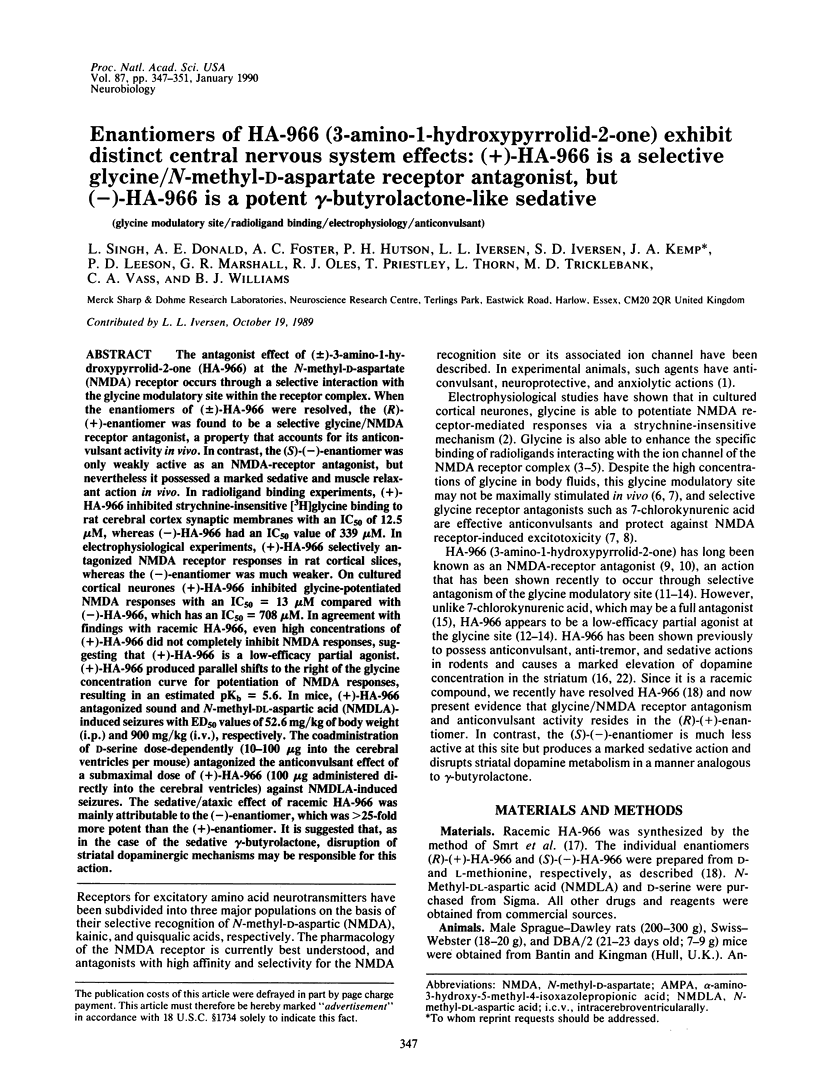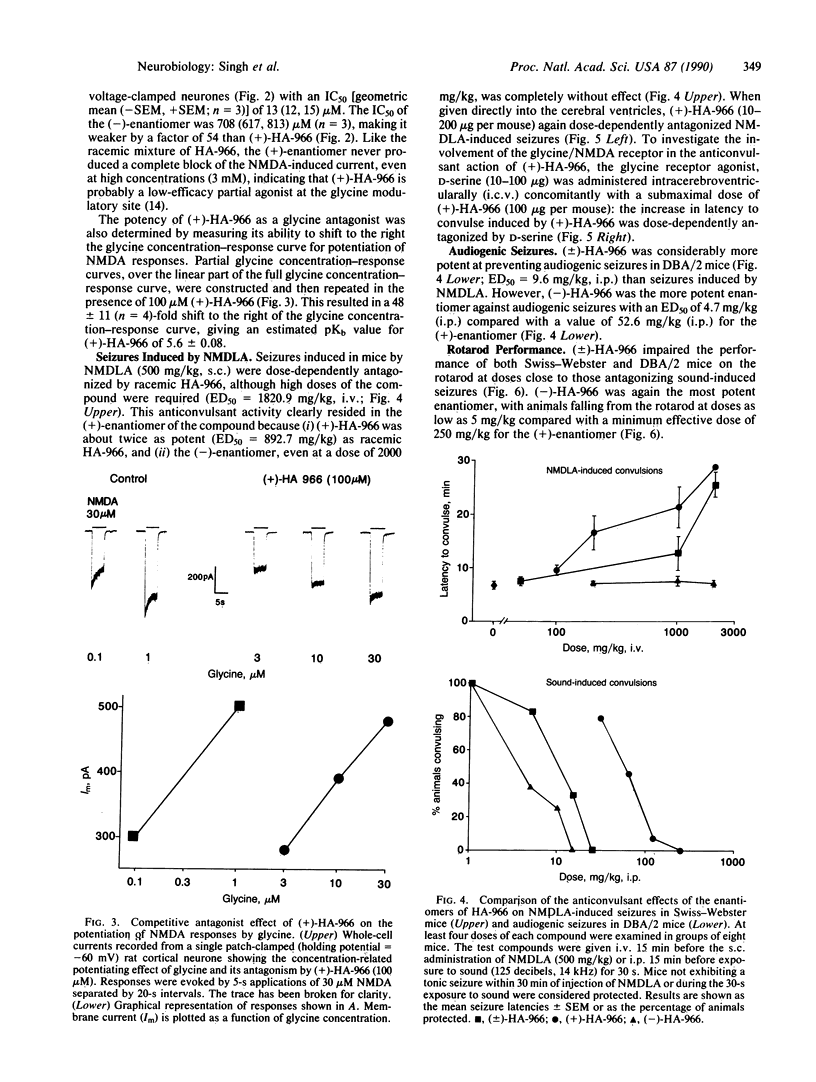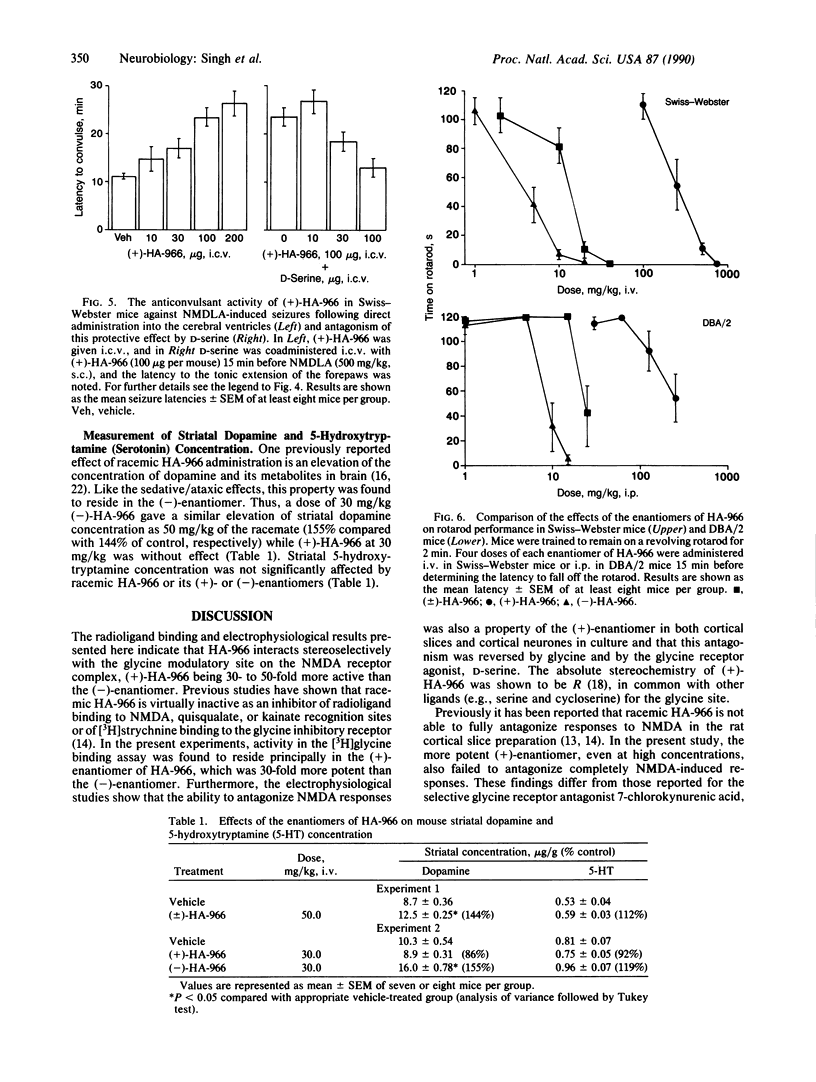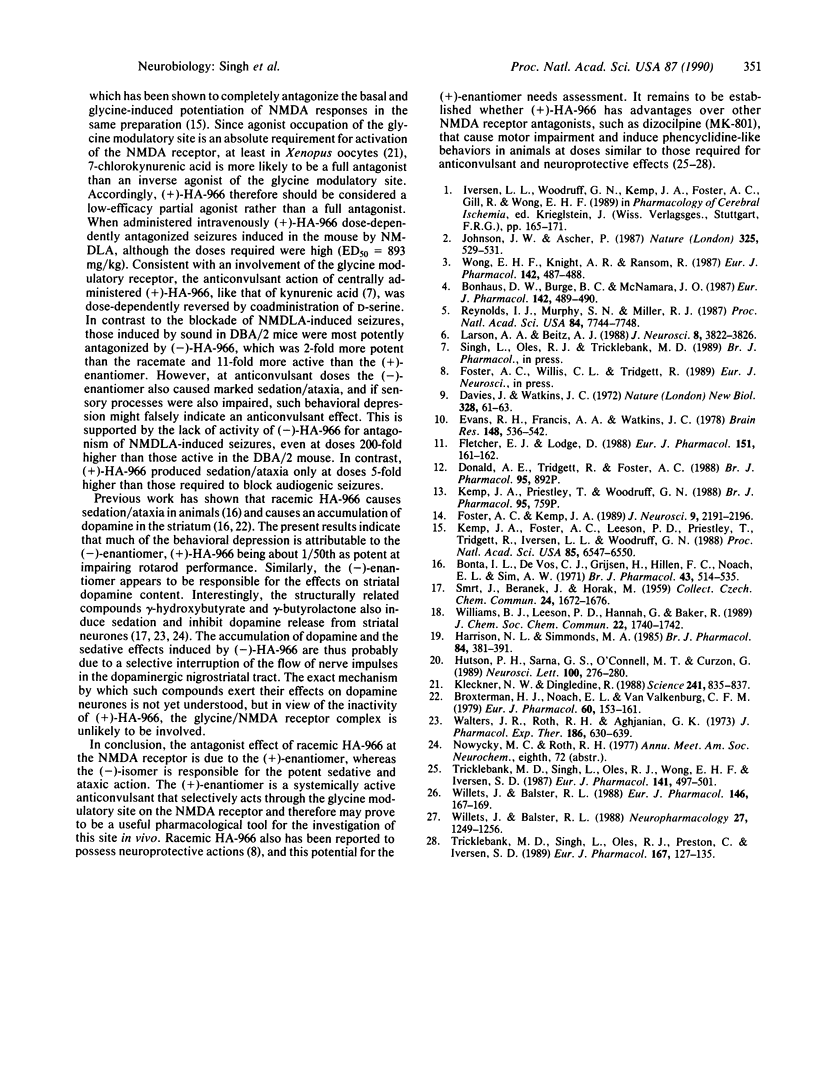Abstract
The antagonist effect of (+/-)-3-amino-1-hydroxypyrrolid-2-one (HA-966) at the N-methyl-D-aspartate (NMDA) receptor occurs through a selective interaction with the glycine modulatory site within the receptor complex. When the enantiomers of (+/-)-HA-966 were resolved, the (R)-(+)-enantiomer was found to be a selective glycine/NMDA receptor antagonist, a property that accounts for its anticonvulsant activity in vivo. In contrast, the (S)-(-)-enantiomer was only weakly active as an NMDA-receptor antagonist, but nevertheless it possessed a marked sedative and muscle relaxant action in vivo. In radioligand binding experiments, (+)-HA-966 inhibited strychnine-insensitive [3H]glycine binding to rat cerebral cortex synaptic membranes with an IC50 of 12.5 microM, whereas (-)-HA-966 had an IC50 value of 339 microM. In electrophysiological experiments, (+)-HA-966 selectively antagonized NMDA receptor responses in rat cortical slices, whereas the (-)-enantiomer was much weaker. On cultured cortical neurones (+)-HA-966 inhibited glycine-potentiated NMDA responses with an IC50 = 13 microM compared with (-)-HA-966, which has an IC50 = 708 microM. In agreement with findings with racemic HA-966, even high concentrations of (+)-HA-966 did not completely inhibit NMDA responses, suggesting that (+)-HA-966 is a low-efficacy partial agonist. (+)-HA-966 produced parallel shifts to the right of the glycine concentration curve for potentiation of NMDA responses, resulting in an estimated pKb = 5.6. In mice, (+)-HA-966 antagonized sound and N-methyl-DL-aspartic acid (NMDLA)-induced seizures with ED50 values of 52.6 mg/kg of body weight (i.p.) and 900 mg/kg (i.v.), respectively. The coadministration of D-serine dose-dependently (10-100 micrograms into the cerebral ventricles per mouse) antagonized the anticonvulsant effect of a submaximal dose of (+)-HA-966 (100 micrograms administered directly into the cerebral ventricles) against NMDLA-induced seizures. The sedative/ataxic effect of racemic HA-966 was mainly attributable to the (-)-enantiomer, which was greater than 25-fold more potent than the (+)-enantiomer. It is suggested that, as in the case of the sedative gamma-butyrolactone, disruption of striatal dopaminergic mechanisms may be responsible for this action.
Full text
PDF




Selected References
These references are in PubMed. This may not be the complete list of references from this article.
- Bonhaus D. W., Burge B. C., McNamara J. O. Biochemical evidence that glycine allosterically regulates an NMDA receptor-coupled ion channel. Eur J Pharmacol. 1987 Oct 27;142(3):489–490. doi: 10.1016/0014-2999(87)90096-3. [DOI] [PubMed] [Google Scholar]
- Bonta I. L., De Vos C. J., Grijsen H., Hillen F. C., Noach E. L., Sim A. W. 1-Hydroxy-3-amino-pyrrolidone-2(HA-966): a new GABA-like compound, with potential use in extrapyramidal diseases. Br J Pharmacol. 1971 Nov;43(3):514–535. doi: 10.1111/j.1476-5381.1971.tb07182.x. [DOI] [PMC free article] [PubMed] [Google Scholar]
- Broxterman H. J., Noach E. L., Van Valkenburg C. F. Differential effects of acute and subacute HA-966 treatment on storage and release of striatal dopamine. Eur J Pharmacol. 1979 Dec 7;60(2-3):153–161. doi: 10.1016/0014-2999(79)90214-0. [DOI] [PubMed] [Google Scholar]
- Evans R. H., Francis A. A., Watkins J. C. Mg2+-like selective antagonism of excitatory amino acid-induced responses by alpha, epsilon-diaminopimelic acid, D-alpha-aminoadipate and HA-966 in isolated spinal cord of frog and immature rat. Brain Res. 1978 Jun 16;148(2):536–542. doi: 10.1016/0006-8993(78)90744-8. [DOI] [PubMed] [Google Scholar]
- Fletcher E. J., Lodge D. Glycine reverses antagonism of N-methyl-D-aspartate (NMDA) by 1-hydroxy-3-aminopyrrolidone-2 (HA-966) but not by D-2-amino-5-phosphonovalerate (D-AP5) on rat cortical slices. Eur J Pharmacol. 1988 Jun 22;151(1):161–162. doi: 10.1016/0014-2999(88)90711-x. [DOI] [PubMed] [Google Scholar]
- Foster A. C., Kemp J. A. HA-966 antagonizes N-methyl-D-aspartate receptors through a selective interaction with the glycine modulatory site. J Neurosci. 1989 Jun;9(6):2191–2196. doi: 10.1523/JNEUROSCI.09-06-02191.1989. [DOI] [PMC free article] [PubMed] [Google Scholar]
- Harrison N. L., Simmonds M. A. Quantitative studies on some antagonists of N-methyl D-aspartate in slices of rat cerebral cortex. Br J Pharmacol. 1985 Feb;84(2):381–391. doi: 10.1111/j.1476-5381.1985.tb12922.x. [DOI] [PMC free article] [PubMed] [Google Scholar]
- Hutson P. H., Sarna G. S., O'Connell M. T., Curzon G. Hippocampal 5-HT synthesis and release in vivo is decreased by infusion of 8-OHDPAT into the nucleus raphe dorsalis. Neurosci Lett. 1989 May 22;100(1-3):276–280. doi: 10.1016/0304-3940(89)90698-8. [DOI] [PubMed] [Google Scholar]
- Johnson J. W., Ascher P. Glycine potentiates the NMDA response in cultured mouse brain neurons. Nature. 1987 Feb 5;325(6104):529–531. doi: 10.1038/325529a0. [DOI] [PubMed] [Google Scholar]
- Kemp J. A., Foster A. C., Leeson P. D., Priestley T., Tridgett R., Iversen L. L., Woodruff G. N. 7-Chlorokynurenic acid is a selective antagonist at the glycine modulatory site of the N-methyl-D-aspartate receptor complex. Proc Natl Acad Sci U S A. 1988 Sep;85(17):6547–6550. doi: 10.1073/pnas.85.17.6547. [DOI] [PMC free article] [PubMed] [Google Scholar]
- Kleckner N. W., Dingledine R. Requirement for glycine in activation of NMDA-receptors expressed in Xenopus oocytes. Science. 1988 Aug 12;241(4867):835–837. doi: 10.1126/science.2841759. [DOI] [PubMed] [Google Scholar]
- Larson A. A., Beitz A. J. Glycine potentiates strychnine-induced convulsions: role of NMDA receptors. J Neurosci. 1988 Oct;8(10):3822–3826. doi: 10.1523/JNEUROSCI.08-10-03822.1988. [DOI] [PMC free article] [PubMed] [Google Scholar]
- Reynolds I. J., Murphy S. N., Miller R. J. 3H-labeled MK-801 binding to the excitatory amino acid receptor complex from rat brain is enhanced by glycine. Proc Natl Acad Sci U S A. 1987 Nov;84(21):7744–7748. doi: 10.1073/pnas.84.21.7744. [DOI] [PMC free article] [PubMed] [Google Scholar]
- Tricklebank M. D., Singh L., Oles R. J., Preston C., Iversen S. D. The behavioural effects of MK-801: a comparison with antagonists acting non-competitively and competitively at the NMDA receptor. Eur J Pharmacol. 1989 Aug 11;167(1):127–135. doi: 10.1016/0014-2999(89)90754-1. [DOI] [PubMed] [Google Scholar]
- Tricklebank M. D., Singh L., Oles R. J., Wong E. H., Iversen S. D. A role for receptors of N-methyl-D-aspartic acid in the discriminative stimulus properties of phencyclidine. Eur J Pharmacol. 1987 Sep 23;141(3):497–501. doi: 10.1016/0014-2999(87)90573-5. [DOI] [PubMed] [Google Scholar]
- Walters J. R., Roth R. H., Aghajanian G. K. Dopaminergic neurons: similar biochemical and histochemical effects of gamma-hydroxybutyrate and acute lesions of the nigro-neostriatal pathway. J Pharmacol Exp Ther. 1973 Sep;186(3):630–639. [PubMed] [Google Scholar]
- Willetts J., Balster R. L. Phencyclidine-like discriminative stimulus properties of MK-801 in rats. Eur J Pharmacol. 1988 Jan 27;146(1):167–169. doi: 10.1016/0014-2999(88)90498-0. [DOI] [PubMed] [Google Scholar]
- Willetts J., Balster R. L. The discriminative stimulus effects of N-methyl-D-aspartate antagonists in phencyclidine-trained rats. Neuropharmacology. 1988 Dec;27(12):1249–1256. doi: 10.1016/0028-3908(88)90027-5. [DOI] [PubMed] [Google Scholar]
- Wong E. H., Knight A. R., Ransom R. Glycine modulates [3H]MK-801 binding to the NMDA receptor in rat brain. Eur J Pharmacol. 1987 Oct 27;142(3):487–488. doi: 10.1016/0014-2999(87)90095-1. [DOI] [PubMed] [Google Scholar]


